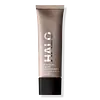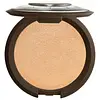Smashbox Halo Healthy Glow Tinted Moisturizer Broad Spectrum SPF 25 Versus Smashbox BECCA Shimmering Skin Perfector Pressed Highlighter
What's inside
What's inside
 Key Ingredients
Key Ingredients

 Benefits
Benefits

 Concerns
Concerns

 Ingredients Side-by-side
Ingredients Side-by-side

Ethylhexyl Methoxycinnamate 6.7%
UV AbsorberTitanium Dioxide 3.1%
Cosmetic ColorantZinc Oxide 1.3%
Cosmetic ColorantWater
Skin ConditioningOctyldodecyl Neopentanoate
EmollientButyloctyl Salicylate
Skin ConditioningDimethicone
EmollientButylene Glycol
HumectantMethyl Trimethicone
Skin ConditioningNiacinamide
SmoothingCetyl PEG/PPG-10/1 Dimethicone
EmulsifyingLauryl PEG-9 Polydimethylsiloxyethyl Dimethicone
Skin ConditioningDiethylhexyl Succinate
EmollientLaureth-4
EmulsifyingTocopheryl Acetate
AntioxidantSodium Hyaluronate
HumectantLecithin
EmollientRosa Hybrid Flower Extract
Skin ConditioningPyrus Malus Fruit Extract
Skin ConditioningLens Esculenta Fruit Extract
Skin ConditioningCitrullus Lanatus Fruit Extract
Skin ConditioningLycium Chinense Fruit Extract
AntioxidantPalmitoyl Hexapeptide-14
Skin ConditioningPeat Extract
Skin ConditioningGold
Cosmetic ColorantSodium Lactate
BufferingMethicone
EmollientSodium PCA
HumectantHydrolyzed Wheat Protein/Pvp Crosspolymer
Glycerin
HumectantCI 77120
Cosmetic ColorantMagnesium Sulfate
Dimethyl Isosorbide
SolventMaltodextrin
AbsorbentTriethoxycaprylylsilane
Dimethicone Crosspolymer-3
Skin ConditioningSilica
AbrasiveAluminum Hydroxide
EmollientDimethicone/PEG-10/15 Crosspolymer
Trimethylsiloxysilicate
EmollientHexylene Glycol
EmulsifyingIsostearic Acid
CleansingCaprylyl Glycol
EmollientStearic Acid
CleansingPolyglyceryl-2 Triisostearate
EmulsifyingDipentaerythrityl Tri-Polyhydroxystearate
EmollientDipropylene Glycol
HumectantSodium Citrate
BufferingBHT
AntioxidantDisodium EDTA
Sodium Benzoate
MaskingPotassium Sorbate
PreservativePhenoxyethanol
PreservativeMica
Cosmetic ColorantCI 77891
Cosmetic ColorantCI 77491
Cosmetic ColorantCI 77492
Cosmetic ColorantCI 77499
Cosmetic ColorantCI 77163
Cosmetic ColorantEthylhexyl Methoxycinnamate 6.7%, Titanium Dioxide 3.1%, Zinc Oxide 1.3%, Water, Octyldodecyl Neopentanoate, Butyloctyl Salicylate, Dimethicone, Butylene Glycol, Methyl Trimethicone, Niacinamide, Cetyl PEG/PPG-10/1 Dimethicone, Lauryl PEG-9 Polydimethylsiloxyethyl Dimethicone, Diethylhexyl Succinate, Laureth-4, Tocopheryl Acetate, Sodium Hyaluronate, Lecithin, Rosa Hybrid Flower Extract, Pyrus Malus Fruit Extract, Lens Esculenta Fruit Extract, Citrullus Lanatus Fruit Extract, Lycium Chinense Fruit Extract, Palmitoyl Hexapeptide-14, Peat Extract, Gold, Sodium Lactate, Methicone, Sodium PCA, Hydrolyzed Wheat Protein/Pvp Crosspolymer, Glycerin, CI 77120, Magnesium Sulfate, Dimethyl Isosorbide, Maltodextrin, Triethoxycaprylylsilane, Dimethicone Crosspolymer-3, Silica, Aluminum Hydroxide, Dimethicone/PEG-10/15 Crosspolymer, Trimethylsiloxysilicate, Hexylene Glycol, Isostearic Acid, Caprylyl Glycol, Stearic Acid, Polyglyceryl-2 Triisostearate, Dipentaerythrityl Tri-Polyhydroxystearate, Dipropylene Glycol, Sodium Citrate, BHT, Disodium EDTA, Sodium Benzoate, Potassium Sorbate, Phenoxyethanol, Mica, CI 77891, CI 77491, CI 77492, CI 77499, CI 77163
Talc
AbrasiveCaprylic/Capric Triglyceride
MaskingIsostearyl Alcohol
EmollientPetrolatum
EmollientSilica
AbrasiveBoron Nitride
AbsorbentNylon-12
Hdi/Trimethylol Hexyllactone Crosspolymer
Dimethicone
EmollientParaffin
PerfumingMicrocrystalline Wax
Emulsion StabilisingPolyethylene
AbrasiveMagnesium Stearate
Cosmetic ColorantSorbitan Sesquioleate
EmulsifyingCalcium Sodium Borosilicate
Synthetic Fluorphlogopite
Triethoxycaprylylsilane
Calcium Aluminum Borosilicate
Tin Oxide
AbrasiveTetrasodium EDTA
Chlorphenesin
AntimicrobialPotassium Sorbate
PreservativeMica
Cosmetic ColorantCI 77891
Cosmetic ColorantCI 77491
Cosmetic ColorantCI 77492
Cosmetic ColorantCI 77499
Cosmetic ColorantCI 77000
Cosmetic ColorantCI 42090
Cosmetic ColorantCI 77400
Cosmetic ColorantCI 77163
Cosmetic ColorantCI 75470
Cosmetic ColorantCI 77289
Cosmetic ColorantCI 77288
Cosmetic ColorantCI 77510
Cosmetic ColorantCI 77742
Cosmetic ColorantCI 77007
Cosmetic ColorantCI 19140
Cosmetic ColorantTalc, Caprylic/Capric Triglyceride, Isostearyl Alcohol, Petrolatum, Silica, Boron Nitride, Nylon-12, Hdi/Trimethylol Hexyllactone Crosspolymer, Dimethicone, Paraffin, Microcrystalline Wax, Polyethylene, Magnesium Stearate, Sorbitan Sesquioleate, Calcium Sodium Borosilicate, Synthetic Fluorphlogopite, Triethoxycaprylylsilane, Calcium Aluminum Borosilicate, Tin Oxide, Tetrasodium EDTA, Chlorphenesin, Potassium Sorbate, Mica, CI 77891, CI 77491, CI 77492, CI 77499, CI 77000, CI 42090, CI 77400, CI 77163, CI 75470, CI 77289, CI 77288, CI 77510, CI 77742, CI 77007, CI 19140
Ingredients Explained
These ingredients are found in both products.
Ingredients higher up in an ingredient list are typically present in a larger amount.
This synthetic powder is used to add a pearly/white color in cosmetics.
Ci 77491 is also hydrated iron III oxide. It's sole purpose is to give a red/pink hue to products.
Iron III oxides are classified as inorganic chemicals for coloring.
Synthetically created Ci 77491 is considered safer than those naturally found. This is because the synthetically created version may contain less impurities. Iron oxides are generally non-toxic and non-allergenic.
Learn more about CI 77491Ci 77492 is also hydrated iron III oxide. It's sole purpose is to give a yellow hue to products.
Iron III oxides are classified as inorganic chemicals for coloring.
Synthetically created Ci 77492 is considered safer than those naturally found. This is because the synthetically created version may contain less impurities. Iron oxides are generally non-toxic and non-allergenic.
Learn more about CI 77492Ci 77499 is also hydrated iron III oxide. It is created from mixing red and black iron oxides. This helps give shades of darkness to a product.
Iron III oxides are classified as inorganic chemicals for coloring.
Ci 77891 is a white pigment from Titanium dioxide. It is naturally found in minerals such as rutile and ilmenite.
It's main function is to add a white color to cosmetics. It can also be mixed with other colors to create different shades.
Ci 77891 is commonly found in sunscreens due to its ability to block UV rays.
Learn more about CI 77891Dimethicone is a type of synthetic silicone created from natural materials such as quartz.
What it does:
Dimethicone comes in different viscosities:
Depending on the viscosity, dimethicone has different properties.
Ingredients lists don't always show which type is used, so we recommend reaching out to the brand if you have questions about the viscosity.
This ingredient is unlikely to cause irritation because it does not get absorbed into skin. However, people with silicone allergies should be careful about using this ingredient.
Note: Dimethicone may contribute to pilling. This is because it is not oil or water soluble, so pilling may occur when layered with products. When mixed with heavy oils in a formula, the outcome is also quite greasy.
Learn more about DimethiconeMica is a naturally occurring mineral used to add shimmer and color in cosmetics. It can also help improve the texture of a product or give it an opaque, white/silver color.
Serecite is the name for very fine but ragged grains of mica.
This ingredient is often coated with metal oxides like titanium dioxide. Trace amounts of heavy metals may be found in mica, but these metals are not harmful in our personal products.
Mica has been used since prehistoric times throughout the world. Ancient Egyptian, Indian, Greek, Roman, Aztec, and Chinese civilizations have used mica.
Learn more about MicaPotassium Sorbate is a preservative used to prevent yeast and mold in products. It is commonly found in both cosmetic and food products.
This ingredient comes from potassium salt derived from sorbic acid. Sorbic acid is a natural antibiotic and effective against fungus.
Both potassium sorbate and sorbic acid can be found in baked goods, cheeses, dried meats, dried fruit, ice cream, pickles, wine, yogurt, and more.
You'll often find this ingredient used with other preservatives.
Learn more about Potassium SorbateSilica, also known as silicon dioxide, is a naturally occurring mineral. It is used as a fine, spherical, and porous powder in cosmetics.
Though it has exfoliant properties, the function of silica varies depending on the product.
The unique structure of silica enhances the spreadability and adds smoothness, making it a great texture enhancer.
It is also used as an active carrier, emulsifier, and mattifier due to its ability to absorb excess oil.
In some products, tiny microneedles called spicules are made from silica or hydrolyzed sponge. When you rub them in, they lightly polish away dead skin layers and enhance the penetration of active ingredients.
Learn more about SilicaTriethoxycaprylylsilane is a silicone used to bind and stabilize ingredients.
As an emulsifier, it helps prevent ingredients from separating. This can help elongate the shelf life of products.
Triethoxycaprylylsilane is often used to coat mineral sunscreens ingredients to help give a better feel. It also helps reduce oxidative stress in sunscreens.
Learn more about Triethoxycaprylylsilane